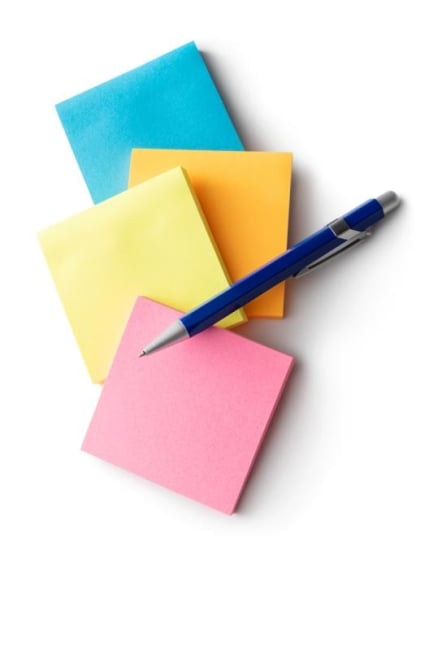You have /5 articles left.
Sign up for a free account or log in.

Floortje/istock/getty images plus
We tend to think about jobs and projects as whole, indivisible experiences: teaching a class, giving a presentation, writing an article. And that pushes us to categorize our feelings and reactions in whole, indivisible ways: I love teaching; I don’t like writing.
But no one (no one!) feels the same way about every single part of their work all the time. Take teaching. As a graduate student, I was really passionate about teaching. But despite that passion, I despised grading. I liked giving students feedback, and I enjoyed watching my students’ progress. But I didn’t like assigning grades, and I hated the feeling I got when I had a bunch of papers to get through and not enough time to do it. If you’d asked me in office hours—working one-on-one with a student—I would have said that I loved teaching. If you’d asked me while grading—faced with a ticking clock and a towering stack of paper—I might have said that I didn’t like teaching at all.
In neither case would I have felt equipped to seek a career that involved more of the things I liked and less of the things I didn’t.
That’s because this kind of total, all-or-nothing approach gets in the way of your self-understanding and your career development. It makes it hard to reflect on and learn from your experiences, and it makes it even harder to use your current work to explore new career possibilities.
Doing that requires pulling your work apart to understand all its pieces and how they relate to one another. So, in this article, I will guide you through a “work breakdown” activity you can do on your own or with friends and colleagues. It is designed help you disrupt the all-or-nothing approach and mine your experiences for insights about your needs, your values and your possible futures.
This activity emerged out of my work with Humanities Without Walls, a multi-institution consortium funded by the Andrew W. Mellon Foundation that is working to reimagine graduate training by fostering collaborative, reciprocal and redistributive methods. As part of a Humanities Without Walls project to develop a portable career curriculum for experiential learning, I collaborated with Margaret Nettesheim-Hoffmann, Benjamin Linzy, Daniel Mueller and Theresa Tobin in the Marquette University Graduate School to design this exercise to enable graduate student interns to reflect on their experiences in creative and disruptive ways.
And now it’s your turn to try it out! As we get started, you’ll need two packs of sticky notes in different colors, a pen, a wall or tabletop, and a chunk of time with minimal distractions.
Break down your work. Think back over the past year and identify two projects you want to reflect on for the duration of this activity. Ideally, pull each of those projects from a different context or different kind of work. If you’re a grad student or postdoc, make one of the projects more academic (writing a paper for a class, collecting data for a dissertation chapter, designing a syllabus) and one of them less (running a student or postdoc group election, planning a PTA bake sale, serving as a union steward).
Now, for each project, identify the individual tasks you did from start to finish. Write each task on a separate sticky note in no more than one or two phrases or sentences. Use one color sticky note for the first project and the other color for the second project.
Aim for at least seven to 10 tasks per project, which means really thinking about the individual steps you took from starting the project to completing it. For example, here is how someone might break down writing a paper for a course:
- Identifying a topic or research question
- Finding and reading literature on the topic
- Analyzing data from primary or secondary sources
- Formulating an argument based on your analysis
- Outlining and structuring the paper
- Writing the first draft of the paper
- Seeking and incorporating feedback
- Editing and polishing the paper
Heads-up: this is harder than you probably think, but it’s also the most important and potentially enlightening step. Take your time and push through.
Once you have your tasks identified, it’s time to start analyzing them. The reason you’ve written all your tasks on individual sticky notes is that it makes it easy to move them around. So let’s get moving.
Sort by confidence. For the first sort, imagine a spectrum on your workspace that goes from “felt more confident” on the left to “felt less confident” on the right. (You might even write these phrases on sticky notes and put them on either side of your space.) Now sort all of the tasks according to whether you felt more or less confident doing them. Another way of thinking about this is whether you felt you were “good at” the task when you were doing it. At this stage, don’t think about whether you liked doing them. (That comes next.)
Once you’ve finished this sort, take a look at your workspace. What do you see? Are the two colors (each representing a different project) evenly distributed, or are they lopsided? That might tell you something about your confidence and skill level in a particular context. Do you notice any other patterns?
You could take a look at the kinds of tasks you find at each end of the spectrum. When we did this activity with a group of talented, curious Marquette University grad students, for example, several noticed that tasks involving work with other people clustered on the low-confidence zone, while solitary work tended to show up more on the other end.
Sort by enjoyment. For this second sort, imagine a new spectrum running from “enjoyed more” on the right to “enjoyed less” on the left. Now re-sort all your tasks along this scale. Really think back to the process of doing each task and assess how much you enjoyed or were energized by those tasks in the moment. Don’t think about the tasks’ importance or significance, just your enjoyment of the immediate process of the task.
Then look for patterns again. Consider how the arrangement of the sticky notes changed from the confidence sort to this enjoyment sort. Did they move around a lot or not much at all? This can help you identify kinds of work that you might be good at but don’t enjoy very much. And knowing that can help you choose work in the future that can build on your strengths without drowning you in stuff you don’t fundamentally like doing. You might also identify things you’re currently bad at but actually enjoy, allowing you to pivot your development in a new and exciting direction.
This is also a place to notice where the different parts of each project fall. If I had done this sort when I was a grad student (with teaching a class as the project), I’d have noticed that many grading-related tasks were way down on the “enjoyed less” side—but not all of them. Providing constructive feedback would have been solidly on the “enjoyed more” side, along with helping students generate ideas and solve problems. That might have helped me realize much earlier that a job like I have now—which is sort of like all office hours and no grading, where I support students but don’t evaluate them—would have been a much better fit than that of a college professor.
Try other sorts. If you’re enjoying this process, you can try sorting the tasks in other ways, such as:
- By how satisfied you felt when the task was finished.
- By how energized and excited each task made you feel.
- By how connected to others you felt during the task.
- By what skills you used to do the task. Consider the broad skill categories in this worksheet, or see what patterns emerge organically from the task.
Or ask yourself other kinds of questions:
- If I had to do three of these tasks every workday for the rest of my career, which would I choose?
- If I asked my friends which of these tasks they most associate with me, what would they pick? What if I asked my supervisor or adviser?
- If you had a job where you could do the tasks you most enjoyed all the time, how often would you be willing to do the task you enjoyed least?
Reflect. Hopefully, by this point you’ve found some new ways to think about your work over the past year. Note down observations or insights that you want to carry with you. Would approach similar projects in different ways in the future, based on what you learned? Are there particular tasks you would want to do in potential jobs after you graduate? Write those down and use them as keywords to search for job ads as part of your career exploration.
This could be a good moment to contemplate how you will tell the story of those projects during your networking or job search. People tend to narrate a period in their work lives as contextually discrete and chronological: you talk about each experience separately, from beginning to end. And as Miriam Bartha has pointed out, academic settings often prime us to think about our abilities in very context-bound ways. But that makes it hard for us to understand how we might use our abilities in other contexts, as well as how to make those abilities legible to others. Activities like the one you just did allow you to see connections—between aspects of grading and aspects of mentoring, for example—that might otherwise have stayed invisible. And that lets you tell the story of you and your work more holistically.
What’s next? Work breakdown activities like the one I’ve described aren’t one-and-done kinds of things. Whether you carefully follow the steps outlined above or take another approach—mind mapping, bullet journaling, freewriting—you should regularly carve out time to reflect on your experiences in a focused and fine-grained way. It’ll help you better understand your work, identify your needs and preferences, and mold a satisfying career now and in the future.




